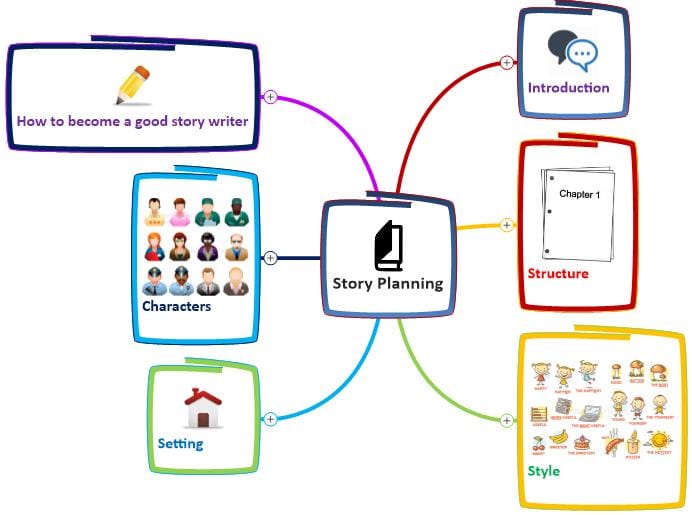Templates
Story Planning
Brainstorm your ideas then sort them into actionable ideas. Use this mind map to help guide you when creating a story plan. Have all your ideas in one place to help you pick up from your last idea.

Don’t have MindGenius installed? No problem, simply start your free trial today to be able to download and open.
1. Story Planning
1.1. Introduction
1.1.1. A well planned story…
1.1.1.1. …has a plot that develops from setting the scene at the beginning…
1.1.1.2. …through the action in the middle…
1.1.1.3. …and to the end where you tell your reader what happens to the characters, clear up any mysteries and tie up any loose ends.
1.1.2. Remember, it’s fine to make rough, scribbled notes when planning
1.1.2.1. (as long as you can read them!)
1.1.2.2. but always use neat, clear writing when it comes to writing the story itself.
1.2. Structure
1.2.1. The first thing to remember is that stories have a beginning, a middle and an end.
1.2.1.1. A story has to be in the right order or your readers won’t understand it.
1.2.2. Beginning
1.2.2.1. The beginning of a story is where you introduce your readers to your style, setting and characters.
1.2.2.2. Often a writer will give his characters a problem to solve.
1.2.2.2.1. This keeps the reader interested, as they’ll want to find out what happens.
1.2.3. Middle
1.2.3.1. In the middle you develop your story.
1.2.3.2. The reader begins to ask more questions and starts to learn what will happen to the characters.
1.2.4. End
1.2.4.1. In the end you tell readers exactly what happens to the characters and how they solved the problems you gave them at the start.
1.2.4.2. Don’t leave any questions unanswered at the end of the story
1.2.4.2.1. Make sure your reader knows what happens to all your characters
1.2.4.2.2. Unless you are planning a sequel, in which case don’t tell the reader everything!
1.2.4.2.2.1. Then they’ll want to read your next story to find out what happens.
1.3. Style
1.3.1. It’s important to get your style right from the beginning.
1.3.1.1. It will help the reader get the feel of your story.
1.3.2. You should use adjectives and adverbs to keep your readers interested.
1.3.2.1. For example, if you are writing a ghost story choose dark, scary adjectives and adverbs to create a dark, scary atmosphere
1.3.3. You can also choose whether your story will have lots of characters, dialogue (people talking) and action, or long, slow descriptive pieces of writing – or all of those things!
1.4. Setting
1.4.1. The setting is the place and time your story is ‘set’.
1.4.2. Letting your readers know where and when your story is set will help bring the story to life.
1.4.2.1. If the setting is somewhere your readers aren’t familiar with then make sure you describe it in detail.
1.4.3. Two stories can be set in exactly the same place, but feel completely different because of the words the writer chooses to use.
1.4.4. Every story needs a setting.
1.5. Characters
1.5.1. List your characters and make a note of what they’re like:
1.5.1.1. What do they look like?
1.5.1.2. What do they sound like?
1.5.1.3. What sort of a person are they?
1.5.2. Make sure you describe them to your reader and that you give them dialogue that suits the sort of person they are.
1.5.3. Some authors give their characters descriptive names.
1.5.3.1. For example, Mr Sneak is likely to be a bad guy…
1.6. How to become a good story writer
1.6.1. Being a good writer isn’t just about planning.
1.6.1.1. The best way to become a good writer yourself is to learn from writers you enjoy reading – so read lots of stories!
1.6.2. Think about how your favourite writers write beginnings, middles and endings.
1.6.2.1. Think about how they describe places and characters, and about how they have chosen words that suit a particular story.
1.6.3. Another way to become better is to read your own stories some time after you have written them.
1.6.3.1. Pretend that someone else wrote the story, see how well you think the story is written and then rewrite it to make it better.
1.6.3.2. Most authors, even famous ones, rewrite their stories many times before they are happy to let someone else read them.
